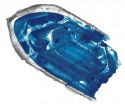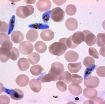(Press-News.org) KANSAS CITY, MO – February 24, 2014 – With less than half of medications including specific labeling for children, Kathleen Neville, MD, MS, a physician at Children's Mercy Hospital, recently led an American Academy of Pediatrics (AAP) committee in updating the policy with new recommendations guiding the off-label use of drugs in pediatric patients. The policy statement, "Off-Label Use of Drugs in Children," was published online today in the March 2014 issue of Pediatrics.
Dr. Neville is chair of the AAP Committee on Drugs and Director of Experimental Therapeutics in Pediatric Cancer at Children's Mercy. The AAP statement offers guidance to physicians using drugs off-label in the treatment of children, particularly in special populations, including preterm infants and newborns, and those with chronic or rare diseases.
The policy statement updates guidance from nearly a decade ago that resulted in more than 500 labeling changes, including expanded labeling with pediatric information.
"Our goal is to provide children with the best care possible, and scientific evidence remains the best way to make treatment decisions," said Dr. Neville. "There's still much work to be done. Ultimately, all drugs used to treat children should have sufficient age-appropriate evidence to support updated labeling."
Experimental Therapeutics at Children's Mercy
Children's Mercy has the largest and most productive pediatric clinical pharmacology program in North America. The program pairs clinicians who identify clinically significant medication-related problems with basic science faculty members who have the expertise necessary to solve them.
Under the direction of Dr. Neville, the Experimental Therapeutics in Pediatric Cancer Program is quickly gaining recognition as a regional referral center, giving children with recurrent or refractory cancer a local option to pursue experimental treatment with early-phase anti-cancer drugs. Neville has had extensive training in experimental therapeutics for children with cancer, and is leading Phase I research efforts to develop new agents for the treatment of pediatric cancer and supportive care for patients.
In collaboration with the Institute for Advancing Medical Innovation (AMI) and the National Institutes of Health (NIH), the team has begun screening compounds, identifying several that appear promising as potential drug development candidates. The program is currently involved in more than 15 Phase I and Phase II trials.
INFORMATION:
About Children's Mercy
Children's Mercy, located in Kansas City, Mo., is one of the nation's top pediatric medical centers. The 354-bed hospital provides care for children from birth through the age of 21, and has been ranked by U.S. News & World Report as one of "America's Best Children's Hospitals." For the third time in a row, Children's Mercy has achieved Magnet nursing designation, awarded to fewer than seven percent of all hospitals nationally, for excellence in quality care. Its faculty of 600 pediatricians and researchers across more than 40 subspecialties are actively involved in clinical care, pediatric research, and educating the next generation of pediatric subspecialists. For more information about Children's Mercy and its research, visit childrensmercy.org or download our mobile phone app CMH4YOU for all phone types. For breaking news and videos, follow us on Twitter, YouTube and Facebook.
Children's Mercy physician leads effort to update AAP policy
Policy statement suggests ways to improve drug safety and efficacy in children
2014-02-24
ELSE PRESS RELEASES FROM THIS DATE:
New study settles how social understanding is performed by the brain
2014-02-24
In a study to be published in Psychological Science, researchers from Aarhus University and the University of Copenhagen demonstrate that brain cells in what is called the mirror system help people make sense of the actions they see other people perform in everyday life.
Using magnetic stimulation to temporarily disrupt normal processing of the areas of the human brain involved in the production of actions of human participants, it is demonstrated that these areas are also involved in the understanding of actions. The study is the first to demonstrate a clear causal ...
New process uses recyclable catalyst to create porous materials
2014-02-24
A team of UConn chemists has discovered a new way of making a class of porous materials that allows for greater manufacturing controls and has significantly broader applications than the longtime industry standard.
The process, more than three years in the making, has resulted in the creation of more than 60 new families of materials so far, with the potential for many more. The key catalyst in the process is recyclable, making it a 'green' technology.
"This is definitely the most exciting project I've been involved in over the past 30 years," says Board of Trustees ...
New insights into the origin of birds
2014-02-24
Mark Puttick and colleagues investigated the rates of evolution of the two key characteristics that preceded flight: body size and forelimb length. In order to fly, hulking meat-eating dinosaurs had to shrink in size and grow much longer arms to support their feathered wings.
"We were really surprised to discover that the key size shifts happened at the same time, at the origin of Paraves," said Mr Puttick of Bristol's School of Earth Sciences. "This was at least 20 million years before the first bird, the famous Archaeopteryx, and it shows that flight in birds arose ...
Policies to green the economy must underpin UK recovery: New report
2014-02-24
The UK urgently needs a green economic strategy to move towards low-carbon prosperity, resource security and environmental quality, says a new report published today by UCL's Green Economy Policy Commission.
The Commission – drawn from a range of academic disciplines across UCL – argues that the UK's current situation of climate instability and increasing resource constraints mean that decisive action is urgently needed by the UK government to green the economy.
Greening the Recovery argues that there is a window of opportunity for policies that acknowledge future ...
Mysterious polio-like illness found in 5 California children
2014-02-23
PHILADELPHIA – Researchers have identified a polio-like syndrome in a cluster of children from California over a one-year period, according to a case report released today that will be presented at the American Academy of Neurology's 66th Annual Meeting in Philadelphia, April 26 to May 3, 2014.
"Although poliovirus has been eradicated from most of the globe, other viruses can also injure the spine, leading to a polio-like syndrome," said case report author Keith Van Haren, MD, with Stanford University in Palo Alto, Calif., and a member of the American Academy of Neurology. ...
Scientists transform skin cells into functioning liver cells
2014-02-23
SAN FRANCISCO, CA—February 23, 2014—The power of regenerative medicine now allows scientists to transform skin cells into cells that closely resemble heart cells, pancreas cells and even neurons. However, a method to generate cells that are fully mature—a crucial prerequisite for life-saving therapies—has proven far more difficult. But now, scientists at the Gladstone Institutes and the University of California, San Francisco (UCSF), have made an important breakthrough: they have discovered a way to transform skin cells into mature, fully functioning liver cells that flourish ...
Oldest bit of crust firms up idea of a cool early Earth
2014-02-23
MADISON, Wis. – With the help of a tiny fragment of zircon extracted from a remote rock outcrop in Australia, the picture of how our planet became habitable to life about 4.4 billion years ago is coming into sharper focus.
Writing today (Feb. 23, 2014) in the journal Nature Geoscience, an international team of researchers led by University of Wisconsin-Madison geoscience Professor John Valley reveals data that confirm the Earth's crust first formed at least 4.4 billion years ago, just 160 million years after the formation of our solar system. The work shows, Valley says, ...
Researchers have identified a novel immunological mechanism of great importance for vaccine developm
2014-02-23
Researchers have discovered the presence of a novel subtype of innate lymphoid cells in human spleen essential for the production of antibodies. This discovery, published in the prestigious journal Nature Immunology, clears the path to the identification of novel strategies to develop more efficient vaccines against encapsulated bacteria, considered highly virulent.
This work was done by the B cell Biology research group at IMIM (Institut Hospital del Mar d'Investigacions Mediques) in Barcelona, directed by Dr. Andrea Cerutti, ICREA research professor and leader in the ...
A key protein is discovered as essential for malaria parasite transmission to mosquitos
2014-02-23
Two teams have independently discovered that a single regulatory protein acts as the master genetic switch that triggers the development of male and female sexual forms (termed gametocytes) of the malaria parasite, solving a long-standing mystery in parasite biology with important implications for human health. The protein, AP2-G, is necessary for activating a set of genes that initiate the development of gametocytes -- the only forms that are infectious to mosquitos. The research also gives important clues for identifying the underlying mechanisms that control this developmental ...
Stream of stars in Andromeda satellite galaxy shows cosmic collision
2014-02-23
The Andromeda Galaxy is surrounded by a swarm of small satellite galaxies. Researchers from the Niels Bohr Institute, among others, have detected a stream of stars in one of the Andromeda Galaxy's outer satellite galaxies, a dwarf galaxy called Andromeda II. The movement of the stars tells us that what we are observing is the remnant of a merger between two dwarf galaxies. Mergers between galaxies of such low mass has not been observed before. The results are published in the scientific journal, Nature.
The galaxies in the early universe started off small and the theory ...
LAST 30 PRESS RELEASES:
Structure of dopamine-releasing neurons relates to the type of circuits they form for smell-processing
Reducing social isolation protects the brain in later life
Keeping the heart healthy increases longevity even after cancer
Young adults commonly mix cannabis with nicotine and tobacco
Comprehensive review illuminates tau protein's dual nature in brain health, disease, and emerging psychiatric connections
Book prepares K-12 leaders for the next public health crisis
Storms in the Southern Ocean mitigates global warming
Seals on the move: Research reveals key data for offshore development and international ecology
Sports injuries sustained during your period might be more severe
World's first successful 2 Tbit/s free-space optical communication using small optical terminals mountable on satellites and HAPS
Can intimate relationships affect your heart? New study says ‘yes’
Scalable and healable gradient textiles for multi‑scenario radiative cooling via bicomponent blow spinning
Research shows informed traders never let a good climate crisis go to waste
Intelligent XGBoost framework enhances asphalt pavement skid resistance assessment
Dual-function biomaterials for postoperative osteosarcoma: Tumor suppression and bone regeneration
New framework reveals where transport emissions concentrate in Singapore
NTP-enhanced lattice oxygen activation in Ce-Co catalysts for low-temperature soot combustion
Synergistic interface engineering in Cu-Zn-Ce catalysts for efficient CO2 hydrogenation to methanol
COVID-19 leaves a lasting mark on the human brain
Scientists use ultrasound to soften and treat cancer tumors without damaging healthy tissue
Community swimming program for Black youth boosts skills, sense of belonging, study finds
Specific depressive symptoms in midlife linked to increased dementia risk
An ‘illuminating’ design sheds light on cholesterol
Who is more likely to get long COVID?
Study showcases resilience and rapid growth of “living rocks”
Naval Research Lab diver earns Office of Naval Research 2025 Sailor of the Year
New Mayo-led study establishes practical definition for rapidly progressive dementia
Fossil fuel industry’s “climate false solutions” reinforce its power and aggravate environmental injustice
Researchers reveal bias in a widely used measure of algorithm performance
Alcohol causes cancer. A study from IOCB Prague confirms damage to DNA and shows how cells defend against it
[Press-News.org] Children's Mercy physician leads effort to update AAP policyPolicy statement suggests ways to improve drug safety and efficacy in children



